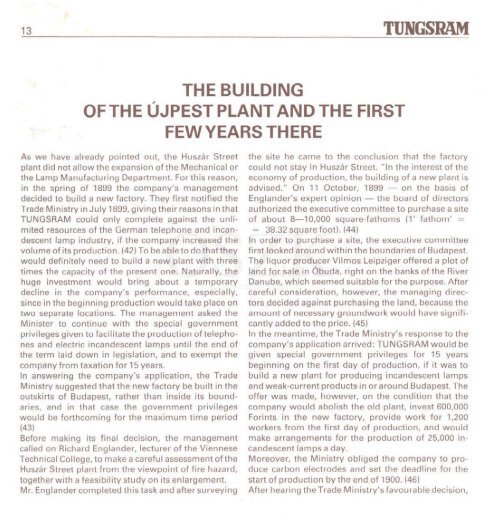THE HISTORY OF TUNGSRAM 1896-1945 - MEK
THE HISTORY OF TUNGSRAM 1896-1945 - MEK
THE HISTORY OF TUNGSRAM 1896-1945 - MEK
- No tags were found...
You also want an ePaper? Increase the reach of your titles
YUMPU automatically turns print PDFs into web optimized ePapers that Google loves.
13 <strong>TUNGSRAM</strong><strong>THE</strong> BUILDING<strong>OF</strong> <strong>THE</strong> UJPEST PLANT AND <strong>THE</strong> FIRSTFEW YEARS <strong>THE</strong>REAs we have already pointed out, the Huszar Streetplant did not allowthe expansion of the Mechanical orthe Lamp Manufacturing Department. For this reason,in the spring of 1899 the company's managementdecided to build a new factory. They first notified theTrade Ministry in July 1899, giving their reasons in that<strong>TUNGSRAM</strong> could only complete against the unlimitedresources of the German telephone and incandescentlamp industry, if the company increased thevolume of its production. (42) To be able to do that theywould definitely need to build a new plant with threetimes the capacity of the present one. Naturally, thehuge investment would bring about a temporarydecline in the company's performance, especially,since in the beginning production would take place ontwo separate locations. The management asked theMinister to continue with the special governmentprivileges given to facilitate the production of telephonesand electric incandescent lamps until the end ofthe term laid down in legislation, and to exempt thecompany from taxation for 15 years.In answering the company's application, the TradeMinistry suggested that the new factory be built in theoutskirts of Budapest, rather than inside its boundaries,and in that case the government privilegeswould be forthcoming for the maximum time period(43)Before making its final decision, the managementcalled on Richard Englander, lecturer of the VienneseTechnical College, to make a careful assessment of theHuszar Street plant from the viewpoint of fire hazard,together with a feasibility study on its enlargement.Mr. Englander completed this task and after surveyingthe site he came to the conclusion that the factorycould not stay in Huszar Street. "In the interest of theeconomy of production, the building of a new plant isadvised." On 11 October, 1899 — on the basis ofEnglander's expert opinion — the board of directorsauthorized the executive committee to purchase a siteof about 8—10,000 square-fathoms (1' fathom' == 38.32 square foot). (44)In order to purchase a site, the executive committeefirst looked around within the boundaries of Budapest.The liquor producer Vilmos Leipziger offered a plot ofland for sale in Obuda, right on the banks of the RiverDanube, which seemed suitable for the purpose. Aftercareful consideration, however, the managing directorsdecided against purchasing the land, because theamount of necessary groundwork would have significantlyadded to the price. (45)In the meantime, the Trade Ministry's response to thecompany's application arrived: <strong>TUNGSRAM</strong> would begiven special government privileges for 15 yearsbeginning on the first day of production, if it was tobuild a new plant for producing incandescent lampsand weak-current products in or around Budapest. Theoffer was made, however, on the condition that thecompany would abolish the old plant, invest 600,000Forints in the new factory, provide work for 1,200workers from the first day of production, and wouldmake arrangements for the production of 25,000 incandescentlamps a day.Moreover, the Ministry obliged the company to producecarbon electrodes and set the deadline for thestart of production by the end of 1900. (46)After hearing the Trade Ministry's favourable decision.








![Letöltés egy fájlban [4.3 MB - PDF]](https://img.yumpu.com/50159926/1/180x260/letaltacs-egy-fajlban-43-mb-pdf.jpg?quality=85)







